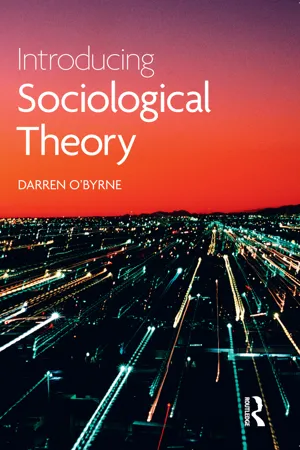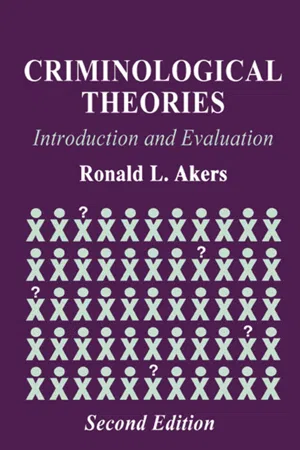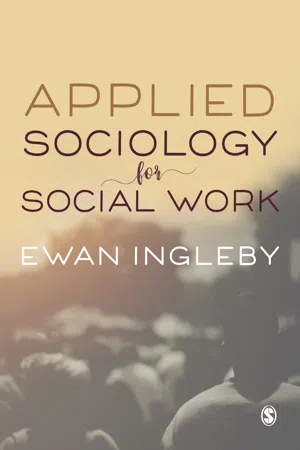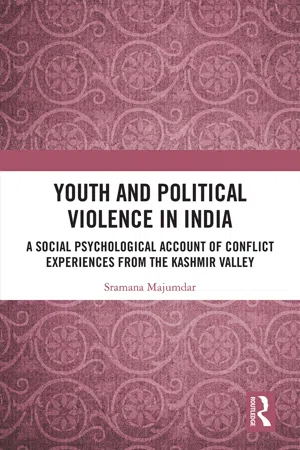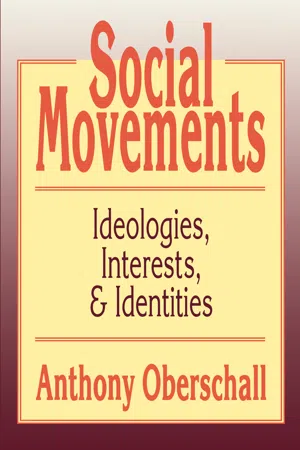Social Sciences
Conflict Theory Culture
Conflict theory culture refers to the perspective that culture is shaped by power struggles and inequalities within society. It emphasizes how dominant groups use culture to maintain their position and control over resources, while marginalized groups may resist or challenge these cultural norms. This approach highlights the role of culture in perpetuating and reinforcing social conflicts and inequalities.
Written by Perlego with AI-assistance
Related key terms
8 Key excerpts on "Conflict Theory Culture"
- eBook - ePub
- Darren O'Byrne(Author)
- 2013(Publication Date)
- Routledge(Publisher)
is , namely, riddled with conflict. In actual fact, among those we can list as conflict theorists, some, such as C. Wright Mills, are clearly quite radical as they want to expose the stark inequalities and abuses of power in society. Some, such as Rex and many of those British Weberians, are a bit more centre-left: they highlight inequalities but don’t necessarily endorse a radical overhaul of the system. A number of them, including Ralf Dahrendorf, are more identifiably liberal in their politics: they believe that while conflicts are an inevitable part of society, these can be effectively contained within the Western liberal democratic model of government (in the related discipline of political science, such an approach is known as ‘pluralism’). But there are also some quite conservative contributions to conflict theory that have appeared in recent years: Samuel Huntington’s ‘clash of civilisations’ thesis, which has inspired American neo-conservative academics and politicians to worry that cultural diversity might stifle ‘Western values’, can be read in this vein.So, to summarise, in this chapter we are looking at a sociological viewpoint which defines its subject matter – society – as an arena of contestation, akin to professional wrestling’s ‘King of the Ring’ competitions, in which the participants are actively trying to promote their own interests vis-à-vis those of their rivals. The interests being promoted can be political, economic or cultural in character – the point is that there is no ‘consensus’ which defines any one society, but a plurality of opinions and values. How one should react to this world of difference is a question of ideology, not sociology. In order to grasp what conflict theory tells us about society, particularly through its single most important concept, that of the interest group - eBook - ePub
Criminological Theories
Introduction and Evaluation
- Ronald L. Akers(Author)
- 2013(Publication Date)
- Routledge(Publisher)
Chapter 8 Conflict Theory DOI: 10.4324/9781315062723-8Introduction
Conflict theory begins with the assumption that society is not held together by agreement and consensus on major values but rather is:[A] congeries of groups held together in a dynamic equilibrium of opposing group interests and efforts. The continuity of group interactions, the endless series of moves and countermoves, of checks and cross-checks…in an immediate and dynamically maintained equilibrium…provides opportunity for a continuous possibility of shifting positions, of gaining or losing status, with the consequent need to maintain an alert defense of ones positions…. Conflict is viewed, therefore, as one of the principal and essential social processes upon which the continuing on-going society depends. (Vold, 1958 :204)Power is the principal determinant of the outcome of this conflict. The most powerful groups control the law, so that their values are adopted as the legal standards for behavior. The members of less powerful groups, though they suffer legislative and judicial defeats, continue to act in accordance with their internal group norms, which means violating the law. Thus, conflict theory offers both an explanation of law and criminal justice and an explanation of criminal and deviant behavior. In the first part of this chapter, conflict theory is contrasted with consensus/functionalist theory as an explanation of law and criminal justice. In the second part, the theory that crime is produced by group and culture conflict is presented and evaluated.Law Is a Type of Social Control
Social control consists of a normative system with rules about the way people should and should not behave, and a system of formal and informal mechanisms used to control deviation from, and promote conformity to, these rules. Informal social control exists in the family, friendship groups, churches, neighborhoods, and other groups in the community. Formal social control includes law and the criminal justice system, in which the rules are officially promulgated and enforced by legally authorized agents. - eBook - ePub
- Ewan Ingleby(Author)
- 2017(Publication Date)
- SAGE Publications Ltd(Publisher)
Chapter 4 Conflict theory and social workConflict theory
Conflict theory is influenced by the ideas of Karl Marx. It is a sociological perspective that is similar to functionalism, with its focus on the social system. Conflict theory is different to functionalism due to the importance that is placed on economics. The perspective explores the material circumstances that produce conflict within social systems. Taylor et al. (2004, p15) emphasise the importance of the concept of ‘ideology’ to conflict theory. Ideology is produced by beliefs and values which are regarded as being based on material circumstances, and is considered to support the values of the rich and powerful sectors of social groups as opposed to the social system’s poor and powerless.Marx is associated with conflict theory and he was especially interested in those aspects of the social system that appear to be contradictory. He also talked about the terms ‘infrastructure’ and ‘superstructure’. Whereas the infrastructure relates to all tangible aspects of the economic system, the superstructure corresponds to systems of belief and the ideas that are generated from these beliefs. According to Marx, the economic infrastructure has a critical influence on the beliefs and ideas of the superstructure. He draws attention to the importance of social classes. The traditional Marxist emphasis is placed on the existence of two main social groups: a ruling class and a subject class. The contradictory circumstances of these two social classes form the basis of conflict within society according to conflict theorists, and Marx argues that there are a series of fundamental contradictions within capitalist societies. This interest in contradictions links Marx’s philosophy to the work of Georg W. F. Hegel, and the exemplification of such contradictory relationships can be seen in the traditional working arrangements for factories. In contrast to the workers who are traditionally regarded as being ‘on the factory floor’, the factory manager is usually based in a private office. Another example of a contradictory relationship occurs with private ownership: a few powerful individuals own companies, whereas the majority of the population own very little in comparison. Marx argues that these contradictions in society are the basis of instability and conflict. This is the rationale behind the prediction that a revolution will occur within capitalist societies that will lead to a redistribution of wealth and the establishment of a communist society. Marxism is a profound and complex social theory. As noted previously, the emphasis on ‘conflict’ can be traced back to the influence of Hegel’s philosophical idea of a ‘thesis, antithesis and synthesis’ being present within the social world (Audi 1999). It is acknowledged that a social revolution will only occur when the working class become fully aware of the unfair contradictions that exist within the social system. The argument runs that, until this realisation occurs, the social system is likely to survive because of the ‘false consciousness’ of the working class. It is only when the working class become fully aware of the implications of social contradictions and of the need to replace the existing social order with a communist society that a social revolution will occur. - eBook - ePub
Youth and Political Violence in India
A Social Psychological Account of Conflict Experiences from the Kashmir Valley
- Sramana Majumdar(Author)
- 2019(Publication Date)
- Routledge India(Publisher)
In the last three centuries, conflict has been a fundamental area of study among many important schools of thought. Some of the major theories that have influenced conflict research are:- Marxism—The Marxian approach, developed by Marx and Engels in the late 19th century, views social conflict as a natural outcome of social inequalities that exist in society and necessitate the rise of the oppressed in the form of social change or revolution. While economic power differentials lie at the heart of any Marxian explanation, the theory extends to all sectors of society and includes social oppression as well. Critics question the absolute dependence on a class system that this theory adheres to and the belief that inequality and conflict can be eliminated if the institution of class is removed. In actuality, no society has been free of class, and the imagination of a classless society is considered utopic by many. Moreover, social differences and other mediums of dominance, like race, gender, community and religion, are sometimes more immediately associated with the emergence of conflict. However, a Marxian perspective can never be completely ignored because all forms of social differences are ultimately representative of class or lead to the occupation of specific class identities, thus involving an aspect of unequal access to resources common to most contexts of violent conflict. Conflicts may emerge from other differences between people, but most ultimately result in further polarization of classes and disproportionate suffering for those who are economically less privileged.
- Structural-Functionalism—A structural functional approach that grew in America over the first half of the 20th century through the works of scholars like Parsons and Durkheim (Kingsbury & Scanzoni, 1993), views society as a self-regulating, functional organism that has the capacity to change and adjust to inputs from the external environment. The social system remains in a homeostatic state or state of equilibrium and order that is only disturbed when a radical change in the environment temporarily puts the system in disorder. Thus, social change is seen as inherent in the social system and is usually gradual and resolvable. This is seen as a state of conflict, which is, however, only temporary under this approach until the society “self regulates back to equilibrium or some sort of normative structure that individuals adhere to” (Conteh-Morgan, 2004, p. 52). This theoretical approach, though influential in social sciences, has been strongly criticized over time as elitist and partisan in explanation. The concept of social order has been widely questioned because in reality, societies are marked by inequalities of many forms and may only be functional for the elite or powerful. Moreover, protracted conflicts and similar cases of prolonged intense conflicts directly challenge the concept of self-regulation that is promulgated by this theory as they often last for several decades and show no signs of resolution that will ensure lasting peace and order.
- Carol L. Langer, Cynthia Lietz(Authors)
- 2014(Publication Date)
- Wiley(Publisher)
Social workers can easily point to the many conflicts that emerge from practice settings. Parents have conflict with a child; a child has conflict with a teacher; and a client has conflict with a department of social services. Social workers may be involved in the conflict or may be called upon to resolve the conflict. Some people avoid conflict because they think it is a distressing and unpleasant experience. For social workers, however, conflict can be a signal that change may be possible. Values and ethics guide social work practice, and social workers are required to advocate social and economic justice; they may conflict with existing social policy and service delivery systems. Social workers are sometimes called change agents. Creating and sustaining change can be uncomfortable and contentious. Social workers learn that conflict may be inevitable but can have good outcomes.This chapter discusses conflict theory. Despite the terminology, conflict theory is more of a perspective than a theory. It is a large view and can be widely applied across systems, but it does not have a step-by-step plan. Therefore, it may vary in application and is difficult to measure. Conflict theory is analytic and descriptive; its assumptions help social workers to understand what is driving a conflict. Social workers learn that conflict is more than a disagreement about a curfew or picking up dirty socks and putting them in the clothes hamper. The chapter therefore discusses the historical development of conflict theory. The theory’s key concepts and principles are discussed. Strengths and limitations of conflict theory are also identified. Finally, two case examples are provided to illustrate the theory.A Historical Discussion of Conflict Theory
Contemporary conflict theory has its roots in classical Marxism. Marx’s political economic theory, termed dialectical materialism, provides the foundation for understanding and distinguishing power differentials in relationships (Marx & Engels, 1848/1955; Marx, 1887). Marx believed that the economic form that any society used created the dynamics of all other social institutions. He thought capitalism was particularly damaging to people and institutions. A dialectic is essentially an ongoing debate. There are always at least two sides to an issue. As those perspectives are debated and act upon each other, a new debate emerges. Marx called his theory materialism because he believed that people needed to talk about real things in theoretical terms and he was discontent to leave theorizing as an abstract. Through dialectical materialism, essential assumptions of conflict theory were formed as follows: (a) conflict is inevitable, (b) there is an unequal distribution of power in relationships, (c) there is an ongoing struggle for scarce resources, and (d) whoever has the most power controls the distribution of resources, also summarized in Table 5.1- eBook - ePub
Rethinking Sociological Theory
Introducing and Explaining a Scientific Theoretical Sociology
- Stephen K. Sanderson(Author)
- 2015(Publication Date)
- Routledge(Publisher)
2 I have tried to formalize conflict theory by summarizing it in terms of the following set of propositions:1. The essence of social life is people competing for resources, which are often scarce.2. Economic resources and social power are the most important, but not the only, resources that people seek.3. Individuals and groups frequently come into conflict over the distribution of resources.4. This conflict commonly leads to the formation of dominant and subordinate groups.5. Conflict is both intrasocietal and intersocietal.6. On the intrasocietal level, dominant groups tend to gain priority over subordinate groups in influencing the structure of society so as to favor their interests.7. On the intersocietal level, societies seek to realize their interests through controlling, and often dominating, other societies.It is important to be clear about the meaning of the term conflict . It is often assumed that it always involves some sort of overt hostility, such as war, revolution, race riots, and the like. These are indeed important forms of conflict, but conflict theorists use the term much more broadly. The essential meaning of conflict here is opposition of interests . Individuals and groups are engaged in conflict whenever they are struggling for ends so that the gains of one party create losses for another party (or parties). For example, in Marxian conflict theory, the capitalist class seeks profit, which it can only earn by the exploitation of the working class. It is also important to recognize that conflict theory does not focus simply on conflict. It is interested in explaining all aspects of social life, harmony as well as conflict, cooperation as well as competition. In conflict theory, conflict as a result of clashing interests is the explanans, and its explananda are wide ranging and diverse. I make this simple point because some sociologists have taken works like Lewis Coser’s The Functions of Social Conflict 3 - eBook - ePub
Social Movements
Ideologies, Interest, and Identities
- Anthony Oberschall(Author)
- 2017(Publication Date)
- Routledge(Publisher)
“Social” conflict refers to conflict in which the parties are an aggregate of individuals, such as groups, organizations, communities, and crowds, rather than single individuals, as in role conflict. Group conflict is used as a synonym of social conflict in this chapter. Finally, social conflict refers in common usage to interaction in which the means chosen by the parties in pursuit of their goals are likely to inflict damage, harm or injury, but not necessarily in every case. With this small proviso, Coser’s definition of social conflict conveys its meaning very well (1967, 232): “social conflict [is] a struggle over values or claims to status, power, and scarce resources, in which the aims of the conflict groups are not only to gain the desired values, but also to neutralize, injure, or eliminate rivals.” Social conflict encompasses a broad range of social phenomena: class, racial, religious, and communal conflicts; riots, rebellions, revolutions; strikes and civil disorders; marches, demonstrations, protest gatherings, and the like.The Scope of Conflict Theories
Just what do theories of social conflict seek to explain? Any comprehensive theory of social conflict should encompass the following topics:- The structural sources of social conflict, in particular structures of domination that make struggles over values and scarce resources likely. At this stage, a theory of social conflict will rely heavily on stratification, social change, and macrosociological theories. These theories will identify the most important explanatory variables in conflict theories.
- Conflict-group formation and the mobilization for collective action of challenging groups and their targets: for this topic, theories of collective action, recruitment, participation, commitment, and internal structure will be especially useful.
- The dynamics of conflict: processes of interaction between conflict groups; the forms of conflict; its magnitude, scope, and duration; escalation and de-escalation; conflict regulation and resolution; the consequences of conflict outcomes for the contending groups and the larger society. These are the most important dependent variables of social conflict theories.
- eBook - ePub
Resolving Conflicts at Work
Ten Strategies for Everyone on the Job
- Kenneth Cloke, Joan Goldsmith(Authors)
- 2011(Publication Date)
- Jossey-Bass(Publisher)
As we begin this examination of the conflicts in our work lives, let us not be prisoners of their hidden dynamics, or strangers to ourselves and one another. Let us agree to explore the cultural shapes and dynamics of our conflicts, where their hidden meanings suddenly become clear. Let us no longer experience them as dungeons, but as opportunities for learning and improvement, and as journeys that can take us far beyond the seemingly insurmountable differences that somehow keep us imprisoned.Decoding the Culture of ConflictWhat is it that keeps us imprisoned and stuck in conflict? In the first place, it is our perceptions of what has happened, including the issues over which we are arguing, the character of our opponent, our own inner nature, the ways we are able to think about and respond to it, the history of our relationship, and the unspoken expectations and assumptions in our workplaces and organizations about the meaning of conflict, whose fault it is, and what can or ought to be done about it.A useful way of thinking about all of these perceptions, expectations, and assumptions is that they form part of, and are influenced and defined by the culture , or more specifically, by what we think of as the “culture of conflict” that is present, though largely unspoken and undiscussed, in every workplace and organization.It may help to think of your own culture of conflict in the following way. Every society, organization, workplace, group, family, and ongoing intimate relationship creates not only occasional conflicts and disagreements, but a complex set of words, ideas, values, behaviors, attitudes, expectations, assumptions, archetypes, customs, and rules that powerfully influence how its members think about and respond to them.These cultures of conflict are shaped by our previous experiences, particularly in our families of origin. They set the basic parameters and “default settings” for what we consider possible when we are in conflict, and define what we can reasonably expect to happen, both from ourselves and from others. They shape our capacity to ask questions, alter how we see our opponents and ourselves, and tell us what is acceptable and what is not.
Learn about this page
Index pages curate the most relevant extracts from our library of academic textbooks. They’ve been created using an in-house natural language model (NLM), each adding context and meaning to key research topics.
